Memorable Meals In Mexico 3: Tierradentro
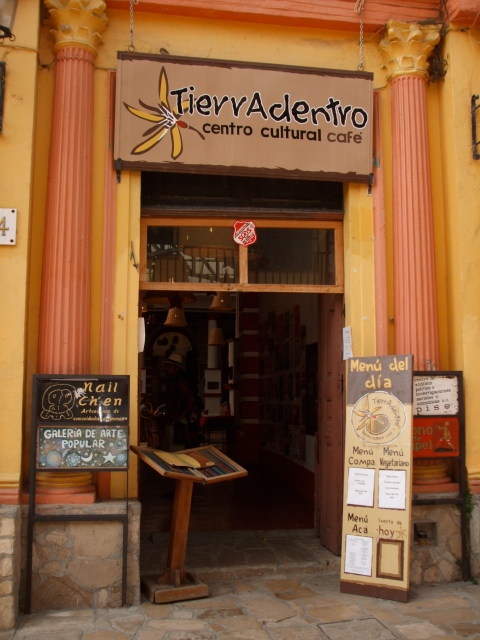
Tierradentro is a cultural center and cafe located at No. 24, Calle Real de Guadalupe, one of the principal streets in San Cristóbal, a block away from the main plaza, in the southern Mexican state of Chiapas. It is situated in a large, open, airy courtyard, ringed by a couple of offices and four shops selling crafts behind the portales of the courtyard.
I had walked past it a few times without entering, before seeing that it appeared in one of the five best restaurants in the New York Times list of recommended restaurants in San Cristóbal. I first ate there one evening with Lupita, a Mexican friend, with whom I was travelling in Chiapas. The food was good. Very fresh, in the style of Mexican comida casera, which translates as home-cooked food.
I ate enchilidas verdes. The green salsa was spicy without taking the roof of my mouth off, and the rolled tortillas were generously stuffed with chicken. Lupita and I shared guacamole, which was also good. My overall impression was of fresh, tasty food at very good value for money.
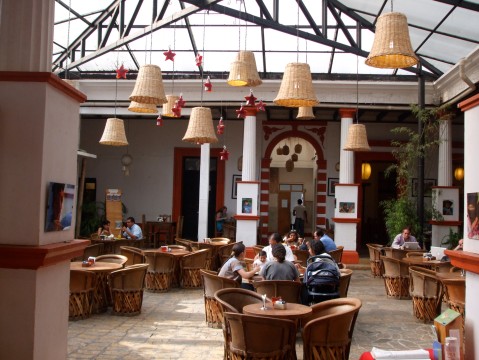
I noticed that many people there were using their computers – unusually, a preponderance of Macintosh’s, which might say something about the kind of people to be found here. I resolved to return the next day for lunch so I could make use of the wi-fi connection, as well as explore the menu further.
The following day, after visiting the two nearby indigenous towns of San Juan Chamula and San Lorenzo Zinacantán, I returned to the restaurant for lunch with Lupita. This occasion we both selected different versions of the menu del día. I ate sopa azteca, followed by fish in a chile chipotle sauce. Lupita also chose sopa azteca, then pescado a la veracruzana (fish cooked in a mild sauce of tomato, onion, olives and coriander).
Sopa azteca is a soup made with strips of fried tortillas, a tomato salsa, avocados and cheese. Lupita, an aficianado of many sopas aztecas, said that the soup was “en su punto”, that is to say, just as it should be. The soup was served at just the right temperature, the tortilla strips were crisp, the sauce perfectly flavoured, and the cheese exactly the right melting consistency.
I thought my fish was superb. Like the enchiladas verdes the previous night, the salsa was picante (hot) but not so hot that other the tastes are overwhelmed. The fish itself was succulent and fresh. Lupita said her fish, too, was excellent.
The cost for all this delicious food including a glass of aguafresca made with melon was 53 pesos, that is less than 5 US Dollars. The information given in the NYT web-page was that there was a fixed price menu of $30! Yet again showing that we should not believe all we read in the papers. The NYT site also said that it is a “Zapatista run cafe”. More misinformation!
Luckily, I was able to talk to Ernesto, who coordinates the restaurant, to understand the context, philosophy and administration of the center. It was this discussion that made the meal memorable. The food here is good, but what is really significant and memorable is the vision that the restaurant is in the process of realising. Ernesto is a deeply thoughtful man, who has been a committed social activist for fifteen years, and is the founder of a Human Rights Organization in San Cristóbal called CAPISE.
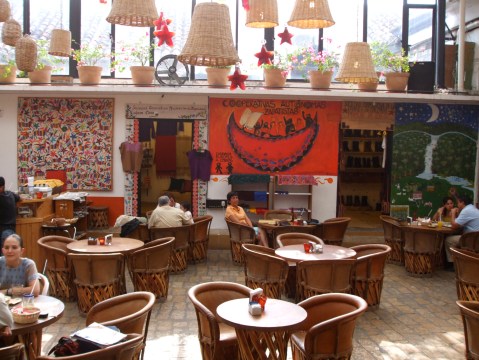
A few years ago, Ernesto and his colleagues in CAPISE had the idea of creating a space in the center of San Cristóbal, which would serve a number of functions.
- To be a “territorio rebelde en el corazón de San Cristóbal”. This means, loosely translated, creating an alternative presence in the heart of the city. “Territorio rebelde” has a particular significance in Chiapas as it is the name the Zapatistas give to their self-governing communities.
- It would offer good quality food at reasonable prices.
- It would be a cultural and social center, promoting activities like concerts, talks, dances, book presentations and offering a meeting venue for NGO’s.
- It would offer a space for co-operatives working in the Zapatista autonomous communities to showcase and sell high quality crafts at fair prices.
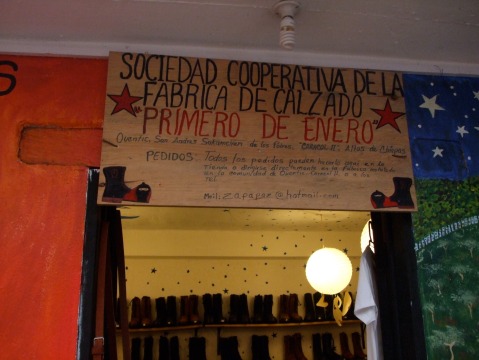
Co-operative selling boots and other leather goods
- Moreover, the profits from the restaurant could be used to help support the work of CAPISE and social projects, like providing electricity to marginalised communities.
The center has been active for nearly three years now, and has been a great success. As I talked more with Ernesto, I was struck by the complexity of the challenges and the depth of thinking involved in creating this remarkable project.
It is not a conventional business, where the primary and generally sole aim is to make a profit, although it shares with any business the need to market itself, sell its products and make a profit, or at least break even, in order to survive. As well as sharing these typical features of any business, this project is very different in wanting to offer an alternative. The following are three important aspects of this which I discussed with Ernesto:
1. The center does not sell Coca-Cola nor any of the products associated with this company and its affiliates, like Ciel in Mexico. This is for three principal reasons:
a) As a Human Rights organization, CAPISE believes that everyone should have free access to decent drinking water. Coca-Cola is actively involved throughout the world in trying to privatise water supply. It is the policy of the cafe to provide free drinking water via an ozone filter.
b) In San Cristóbal, Coca-Cola was given permission to build its factory on the slopes of the nearby Huitepec ecological reserve. This means that the company has privileged access to the water from the reserve. CAPISE has so far been unable to find out from either Coca-Cola or the local government what the company is paying for this service.
c) Mexico has the highest rate of childhood obesity in the world and the most rapidly growing rate of overall obesity. with all the negative health consequences implied by this. Many people believe this is linked to the high consumption and aggressive marketing of fizzy drinks like Coca-Cola.
Coincidentally, on the morning I left San Cristóbal and went to Tierradentro for a final goodbye coffee, a promotion for Coca-Cola was happening a few doors down the street.
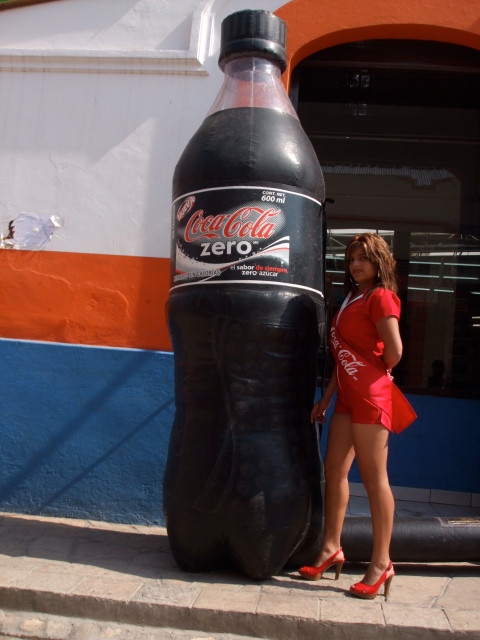
Coca-Cola using traditional marketing techniques to promote its product
2. The center buys its coffee directly from co-operatives within the Zapatista controlled areas. Its policy is to buy the best organically produced café arábigo, which is usually exported to Europe, so that it is available to local people. It also believes in paying the price asked by these co-operatives without bargaining. Within this frame of reference, it is able to offer a truly excellent double expresso at 17 pesos (just over 1 USD) and sell one kg of high quality coffee at 90 pesos. Starbucks charges 160 pesos for the same quantity and quality.
3. When the center was first created it had to make a policy about how to deal with children and indigenous people coming into the cafe to sell products. Initially the center had not wanted to exclude them. However, word got around the street that this was a place in which street sellers were permitted with the consequence that many street sellers were continually coming to the center throughout the day. To deal with this, rather than exclude them, which is the policy in many San Cristóbal restaurants, it was agreed that street sellers could enter, but they could not return within a period of three hours.
To manage a project which has to survive in conventional terms as a business, but which also aims to offer an alternative to the the exploitative features of a normal commercial model, requires, in my opinion, much higher levels of leadership ability, team-working and creative thinking. It is to the credit of all at Tierradentro that they are achieving this.
As the short poem, by the Uruguayan writer Eduardo Galeano, says, that is quoted in the menus:
“La utopía está en el horizonte
Camino dos pasos, ella se aleja dos pasos
y el horizonte se corre diez pasos más allá.
¿Entonces para qué sirve la utopía?
Para eso, sirve para caminar.”
“Utopia is on the horizon
I walk two steps, it retreats two steps
and the horizon goes back ten steps further.
Therefore, what use is a utopia?
Exactly for this, that it sets the direction to walk in.”
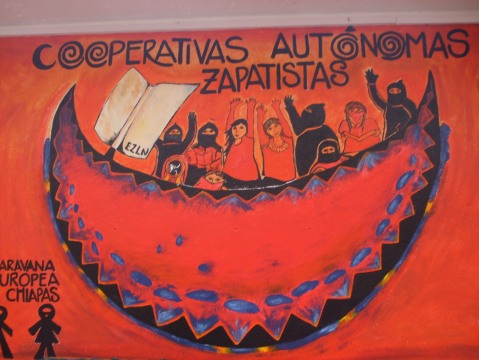
PS For a good summary of the Zapatistas and their struggle click here on the Wikipedea article about them.
Well spotted once again! Thanks for sharing Ernesto’s inspirational story.
Como siempre,buen trabajo Paul. Buena reseña de la labor que realiza CAPISE en San Cristobal y excelente motivación para visitar TIERRA ADENTRO.
[…] in these huge companies giving their commitment to the conservation of wilderness. In an earlier post about Chiapas, I wrote how a Human Rights organization there was organizing the boycotting of Coca […]
[…] which was great and also very cheap. There’s an interesting interview with the owner here, if you’re interested in knowing more about why the movement opened a place to […]
[…] food aside, you can read a short interview with the founder of the cafe, Ernesto, here – there isn’t much, but it covers thing like the brands that they choose to work with and […]